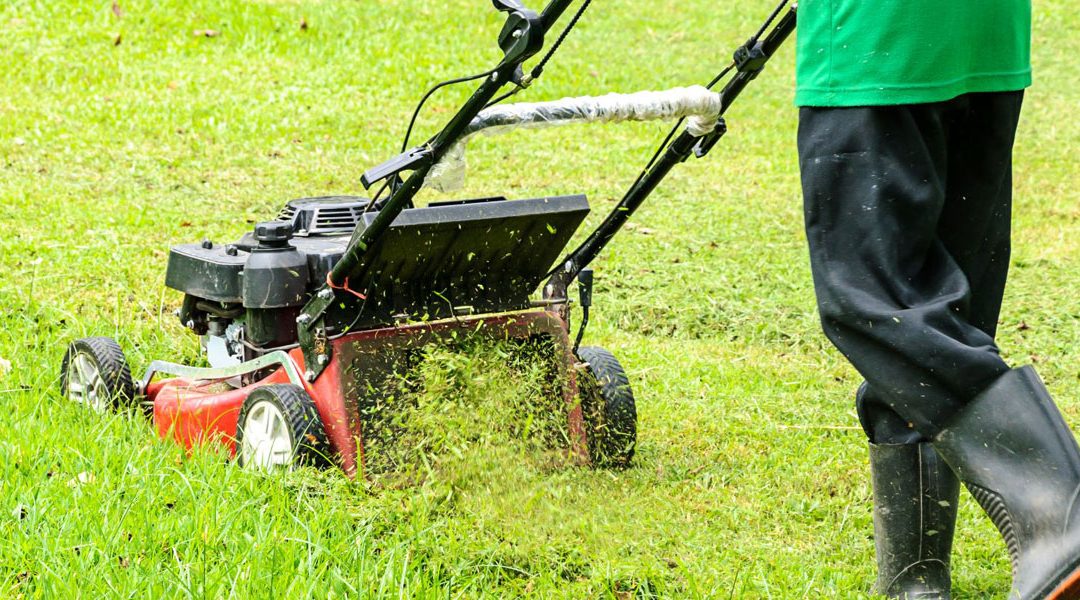Lawn mowing is an effective way to promote growth, but it is important to do it properly depending on the time of year.
Mowing your lawn too short, with blunt blades or infrequently can cause problems
LAWN MOWING HEIGHTS
Proper lawn mowing heights are important for all lawn types. The differences in mowing heights can mean big differences in lawn health, thatch control and water usage. Set your mower to the highest preferred setting for your lawn type and only cut about one-third of the grass blades at any one time.
A lawn which is regularly cut too short will result in greater water evaporation from the soil, a stressed lawn and increased water usage. Cutting to short also makes your lawn more prone to weeds. Taller grass blades shade the soil and keep it cooler and help prevent weed seeds from sprouting.
If your lawn is maintained too high, then growth rates and thatch can increase more rapidly.
At all times, you are trying to find just the right balance for our own individual lawn.
MOWING HEIGHTS AND PHOTOSYNTHESIS
Photosynthesis is the process which plants and lawns use to power their growth and food conversion from nutrients into carbohydrate foods.
The longer the grass blade, or the higher it is mowed, will directly impact on how fast or how slow the lawn grows. Longer blades mean a faster growing and repairing lawn, and shorter blades mean a slower growing and repairing lawn.
For instance, Buffalo lawns like to have a longer leaf, and prefer being mowed at a greater than average height when compared to other warm season grass types.
While Zoysia lawns prefer a middle mower height and Couch thrives on one of the lowest mower settings.
MOWING HEIGHTS AND SHADE
Shade is also a very big factor in lawn mowing heights. If you chose a lawn for its shade tolerance and the lawn is planted in an area of high shade, then the mowing height will need to be raised in the shaded part of the yard. This allows the longer leaf blade to trap more sunlight in order to conduct enough photosynthesis for its survival.
SEASONAL MOWING HEIGHTS
As your lawn approaches winter the available daily sunlight reduces, and with it so does the ability for the lawn to photosynthesise its food. In order to maintain a healthier lawn in winter it will be necessary to raise mowing heights prior to and during the winter season. This allows greater photosynthesis and food supply under the low light conditions of winter.
During summer weekly mowing is advised as this is when your lawn will grow the quickest. Always remember not to mow more than one-third of the grass blade.
THE BEST TIME OF THE DAY TO MOW
Mowing your lawn in the early evening means it is usually dry, the sun is less intense, and the lawn has ample time to recover before the arrival of the next afternoon’s heat. Even if it has not rained, lawns are usually moist in the morning.
If it has rained, wait for your lawn to dry before mowing as cutting wet grass can result in uneven trim. Cut wet lawn can also easily clog up your mower and cause it to dump clumps of grass across your lawn. Also, if these clumps are not raked-up they can smother the growing grass and cause brown spots.
MOWING NEW LAWN
Do not mow your lawn until the roots have fully established. To see if your lawn is ready for a mow, grab hold of the lawn matt and see if you can lift it – if it doesn’t lift then you can mow.
The first cut should also be made before the lawn gets too lawn (about 6cm) – depending on the time of year and variety this could be about three weeks. The first cut is very important – with 5cm to 6cm on the first cut being ideal. If the lawn is allowed to grow longer there is the possibility of the finer grasses dying back due to lack of light.
Subsequent mowing’s while the lawn is establishing should not be done below 4cm.
LAWN CLIPPINGS
Feel free to leave your lawn clippings on the lawn when mowing as they can quickly break down and return beneficial nutrients to the soil. However, mow often enough to keep the clippings small as large clumps of clippings can smother the lawn and cause brown patches.
SHARP MOWER BLADES
For the best cut, sharpen your mower’s blades at the first time of wear. Blunt blades tear up the lawn and cause ragged brown edges. Generally, it is recommended to have your mower tuned-up and blades sharpened once a year.
Also remember to clean your mower, either washing or blowing, after each cut to help prevent blockages within the mower itself.

